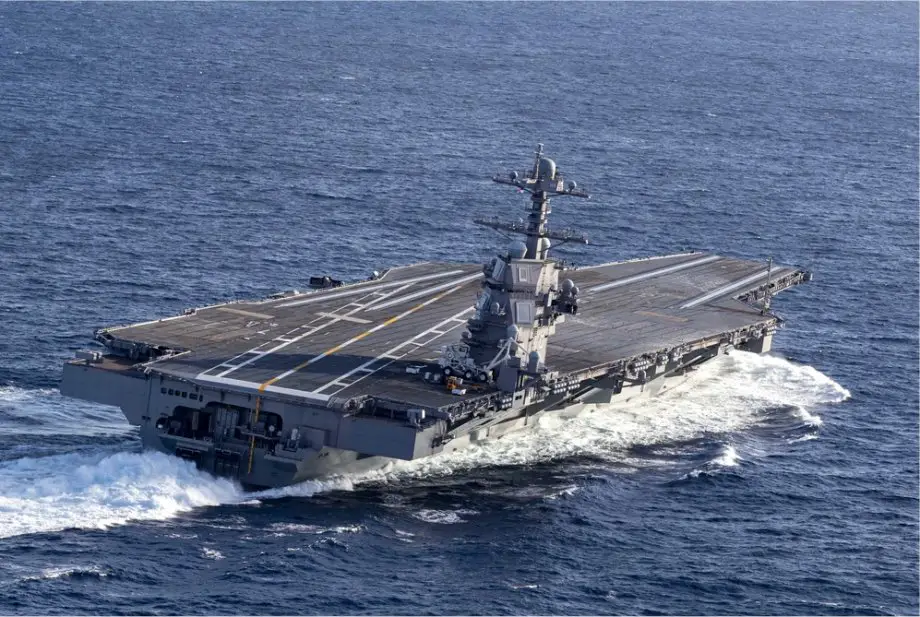Breaking news
US Navy to bring back aircraft carrier USS Gerald R. Ford from Middle East.
According to information published by ABC News on December 31, 2023, the US Navy to bring back their aircraft carrier USS Gerald R. Ford from the Middle East.
Follow Navy Recognition on Google News at this link
 US Navy's aircraft carrier USS Gerald R. Ford. (Picture source: Dvids)
US Navy's aircraft carrier USS Gerald R. Ford. (Picture source: Dvids)
In the last months, the USS Gerald R. Ford (CVN 78), the U.S. Navy's newest and most advanced aircraft carrier, has been a key presence in the Eastern Mediterranean, particularly following heightened tensions in the region due to the Israel-Hamas conflict. The carrier and its strike group were initially on a deterrence mission in Eastern Europe but were quickly retasked following the outbreak of hostilities in early October 2023.
The USS Gerald R. Ford's deployment was extended twice, first in mid-October and then again in mid-November, due to the ongoing conflict and the need for a strong U.S. naval presence in the region.
This extension meant that the Ford and its accompanying warships, including the guided-missile cruiser USS Normandy (CG-60) and several destroyers, remained in the Eastern Mediterranean longer than initially planned.
The destroyers USS Ramage (DDG-61), USS McFaul (DDG-74), and USS Thomas Hudner (DDG-116) were part of this group, with the Ramage returning to Norfolk in early December and the Hudner engaging in drone defense activities in the Red Sea.
As of late December 2023, the Ford was sailing with USS The Sullivans (DDG-68), USS Bulkeley (DDG-84), and USS Delbert D. Black (DDG-119). The Ford and its strike group played a crucial role in deterring the conflict from escalating beyond Southern Israel and provided a significant presence in the Mediterranean Sea.
In early January 2024, it was announced that the USS Gerald R. Ford was finally heading home to Norfolk, Virginia, after an extended deployment of eight months. This return marked the end of a significant period of operations in the Eastern Mediterranean.
The aircraft carrier's departure from the region was part of a broader adjustment of U.S. naval forces, with other warships like the amphibious assault ship USS Bataan and the dock landing ship USS Carter Hall being deployed to the eastern Mediterranean to maintain a U.S. presence.
The USS Gerald R. Ford's departure reflects a shift in U.S. defense posture in the Mediterranean. The Pentagon's decision to bring the Ford home indicates a re-evaluation of the necessity of its presence in the region, with other naval forces taking over its role.
Technical data
The USS Gerald R. Ford is an aircraft carrier with a displacement of about 100,000 long tons (100,000 tonnes) when fully loaded. Its length varies between 1,092 ft (333 m) and 1,106 ft (337 m), with a waterline beam of 134 ft (41 m) and a flight deck width of 256 ft (78 m). The height of the ship is approximately 250 ft (76 m), and it contains 25 decks.
Powered by two Bechtel A1B PWR nuclear reactors that use highly enriched uranium (HEU) at a concentration of 93.5%, the carrier has a propulsion system consisting of four shafts. This enables it to reach speeds in excess of 30 knots (56 km/h; 35 mph). The USS Gerald R. Ford has an operational range that allows for approximately 25 years of service before requiring a mid-life refuel.
The ship has a complement of 4,539 personnel, including its air wing. For its sensor and processing systems, it is equipped with the AN/SPY-3 Multi-Function Radar (MFR) X band active electronically scanned array and the AN/SPY-4 Volume Search Radar (VSR) S band active electronically scanned array.
The USS Gerald R. Ford's armament includes surface-to-air missiles such as 2 × RIM-162 ESSM launchers and 2 × RIM-116 RAM. It also has 3 × Phalanx CIWS, 4 × Mk 38 25 mm Machine Gun Systems, and 4 × M2 .50 Cal. (12.7 mm) machine guns for defense. The carrier can accommodate over 75 aircraft and has a flight deck measuring 1,092 ft × 256 ft (333 m × 78 m), which facilitates the launch and recovery of various types of aircraft.























